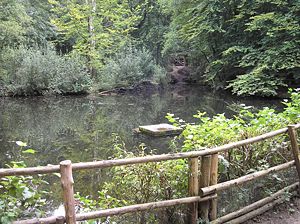
Klever Reichswald
Encyclopedia

Kleve
Kleve , is a town in the Lower Rhine region of northwestern Germany near the Dutch border and the River Rhine. From the 11th century onwards, Kleve was capital of a county and later a duchy...
in North Rhine-Westphalia
North Rhine-Westphalia
North Rhine-Westphalia is the most populous state of Germany, with four of the country's ten largest cities. The state was formed in 1946 as a merger of the northern Rhineland and Westphalia, both formerly part of Prussia. Its capital is Düsseldorf. The state is currently run by a coalition of the...
in Germany
Germany
Germany , officially the Federal Republic of Germany , is a federal parliamentary republic in Europe. The country consists of 16 states while the capital and largest city is Berlin. Germany covers an area of 357,021 km2 and has a largely temperate seasonal climate...
between the Rivers Rhine and Maas
Meuse River
The Maas or Meuse is a major European river, rising in France and flowing through Belgium and the Netherlands before draining into the North Sea...
at the Dutch/German border. The area is wooded and wet.
Main towns in the area are Kleve
Kleve
Kleve , is a town in the Lower Rhine region of northwestern Germany near the Dutch border and the River Rhine. From the 11th century onwards, Kleve was capital of a county and later a duchy...
, Goch
Goch
Goch is a town in the district of Kleve, in North Rhine-Westphalia, Germany. It is situated close to the border with the Netherlands, approx. 12 km south of Kleve, and 27 km southeast of Nijmegen.-Cultural ties:...
, Kevelaer
Kevelaer
Kevelaer is a municipality in the district of Kleve, in North Rhine-Westphalia in Germany. It is the best visited Catholic pilgrimage location within north-western Europe. More than 800,000 pilgrims, mostly from Germany and the Netherlands, visit Kevelaer every year to honour the Virgin Mary.The...
, Geldern
Geldern
Geldern ) is a city in the northwest of the federal state North Rhine-Westphalia, Germany. It is part of the district of Cleves, which is part of the Düsseldorfadministrative region.-Location:...
and Xanten
Xanten
Xanten is a historic town in the North Rhine-Westphalia state of Germany, located in the district of Wesel.Xanten is known for the Archaeological Park or archaeological open air museum , its medieval picturesque city centre with Xanten Cathedral and many museums, its large man-made lake for...
.
In the Second World War, Klever Reichswald was the location of the Battle of the Reichswald, also known as Operation Veritable, in February and March, 1945. In this protracted battle against Anglo-Canadian forces on Germany's Western Front, German lines under the capable General Alfred Schlemm
Alfred Schlemm
Alfred Schlemm was a German General der Fallschirmtruppe in the Wehrmacht. His last command in World War II opposed the advance of the First Canadian Army through the Reichswald in February 1945....
(of the Luftwaffe
Luftwaffe
Luftwaffe is a generic German term for an air force. It is also the official name for two of the four historic German air forces, the Wehrmacht air arm founded in 1935 and disbanded in 1946; and the current Bundeswehr air arm founded in 1956....
) had been reequipped. The Siegfried line was the most fortified in this area, and the troops were re-enforced by elite and experienced soldiers well prepared for protracted fighting. The terrain largely nullified the Anglo-Canadians' advantages in equipment, armament and munitions, and manpower. On the German side, over 90,000 men fought in this battle, and 52,000 were taken prison.
On the Anglo-Canadian side, nearly 200,000 men were engaged in the fighting, with 23,000 casualties.
As the Reichswald is on a glacial ridge it is not subjected to flooding.The glacial gravel contains a lot of loam from the northern German plain and this causes the surface to become extremely muddy when using the unmetalled roads during a rainy period.

